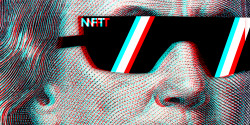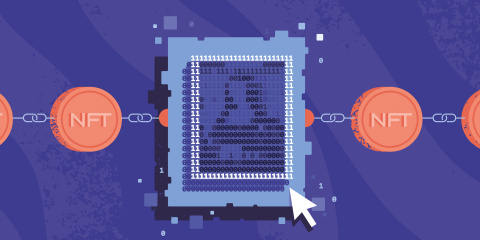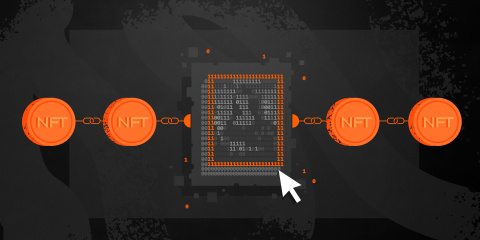
NFT ART: HYPE OR GOLDMINE?
The news is everywhere, once again someone spent an incredible amount of money on a tweet or a digital monkey, Snoop Dogg released a gang of pixelated avatars, even you already asked us at the Open Day if we sell them: NFT - It's hard to imagine the internet without these three letters. But it's not uncommon that the term is still fuzzy to many people and they can't get to grips with the concept. We have dealt with the topic for you! In our 3-part series on NFTs, we look at interesting examples, explore the future of the digital art market, and cast an eye over what it all means for the creative industry. As it turns out, everyone from musicians and photographers to graphic designers can do something with it! In part one, we explain what NFTs are, how they work, and what you can do with them.
Let's start at 0 - What is an NFT anyway?
To explain the concept, we can't get around this standard phrase:
NFT stands for Non Fungible Token
in other words, the opposite of a replaceable good. Money, for example, is a replaceable good; your €2 coin is replaceable by my €2 coin. Pasta is also a replaceable good: if you want to make spaghetti bolognese, it doesn't matter if you grab the front or back pack of spaghetti off the shelf (apart from the expiration date).
Something that is not interchangeable or replaceable, on the other hand, is an original painting by Picasso, an object with emotional value, or, in the digital world, an NFT. In fact, just about anything can be digitized and become an NFT: Songs, videos, photos, digital art, and so on (so as not to go beyond the scope, we will only deal with this type of NFTs here, the NFT art, so to speak). Clear so far? Well... Let's go on!

How does an NFT work?
NFTs are based on blockchain technology in a decentralized database. As the name suggests, a blockchain is a chain of blocks, each of which contains information in chronological order. In the case of an NFT of a digital artwork, such information can be, for example, details about the artist, transaction totals, name of the owner, and so on. Together, this information makes the blockchain unique and unforgeable. Without getting lost in the technology here,
The blockchain makes it possible to assign ownership uniquely and securely. You can think of it as a digital certificate of authenticity.
When you purchase a digital artwork, it's stored in the blockchain.
At this point, it's helpful to consider its tangible counterpart, the physical art market. Imagine bidding highest on a painting at an auction. You've purchased it, and you'll probably get a certificate of authenticity and some sort of receipt confirming your purchase. In the world of NFTs, it's pretty much the same thing - just completely digital.
When you purchase an NFT artwork, it doesn't automatically mean you own all the rights to it. For comparison, if you buy a rare version of a book or album, it doesn't mean you own its content and can do whatever you want with it. Similarly, with original media, if someone creates a physical painting, digitizes it, makes that version available for purchase as an NFT, and you buy it, you own the NFT, but not the original painting. So watch out when buying NFT - find out beforehand what exactly you are buying.
Okay - Now what do I do with it?
This brings us to the next question: You have purchased an NFT artwork - What do you do with it now? You can collect NFTs and trade them. An NFT artwork is a digital asset, a status symbol; like a painting, a yacht, or real estate.
Well almost. You can at least still hang a physical painting on your wall, you can't do that with an NFT artwork, because in general they don't really serve any practical purpose. Still, you can get quite creative with their use. For example, some people create digital art galleries where they show off their collected or self-created NFTs. In a society where VR and metaverses are becoming more and more important, it's a nice idea to display your digital art collections and share them with the world.

Can I create and sell an NFT myself?
You've probably asked yourself that, maybe because you're a musician or graphic designer. There are several platforms where you can buy, sell or create your own NFT art. Popular ones are for example Opensea, Superrare and Nifty. All you need is a crypto wallet with the currency that can be traded on the respective platform.
Just upload your photo, video, song, graphic design visual or any other acceptable format you want to NFT-ify and go through the creation process (most platforms are quite user-friendly). You can set a value for your artwork yourself, or let it go to the highest bidder. Note: Creating NFTs and putting them up for sale can cost fees!
I have to own it! But why?
So where does this hype actually come from? Explaining a trend completely and tracing it back to its roots is often difficult. Why do we collect anything at all? Everyone has to answer this question for themselves. People have always loved to own things that are unique and that others don't have (remember those glittery Pokémon cards, or Diddl blocks? Oh you beautiful nostalgia...). In itself, we determine which things we assign value to, and which we don't.
That's why NFTs of photos, digital artworks and so on are only valuable as long as enough people assign value to them. The way we assign value to things is constantly changing with technology. That's why there are those who assume that the "NFT art market" will eventually collapse once the hype is over. There must be enough people who constantly believe in this market and actively participate in it. How exactly the market will develop, however, remains to be seen. There may still be interesting opportunities for collectors and investors.
Is it worth entering the market?
As with the physical art market, trading NFT art is certainly fun if you are familiar with the market and scene. However, if you approach it with the idea that every NFT will yield a lot of money at some point, you may be in for a sobering surprise. In the "real" world, not every work of art is worth a lot of money. Which work of art gains in value is determined by the market, supply and demand, etc.. Here, various factors such as the fame of the artist, size of the artwork, sales history, and so on play a role.
It should be said - anyone can buy, create and sell NFT art with a few clicks. However, this does not mean that you will get rich overnight here. NFT art is an exciting story, for those who have a little money to spend, for example, or just want to explore potential art markets and get to know them better. Just try it out and see if it's for you - after all, NFTs not only sell for millions of dollars, but some can be bought dirt cheap. Who knows - maybe your very artwork will eventually gain massive value on the market. And just between us - it's cool to own things that nobody else in the world has...
Coming soon in our series on NFTs:
- Interesting and well-known examples on the market
- What does the future hold for NFTs in the creative industry?
